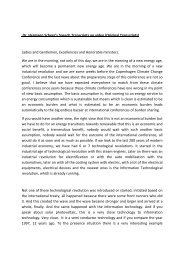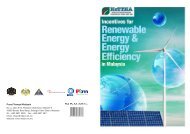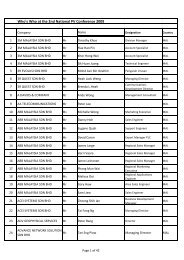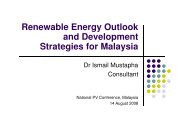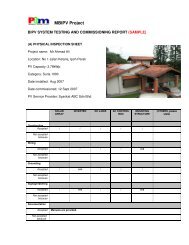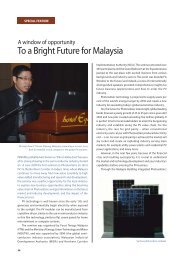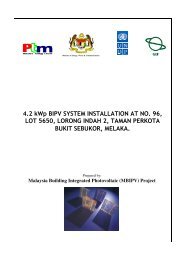MBIPV Project Brief
MBIPV Project Brief
MBIPV Project Brief
You also want an ePaper? Increase the reach of your titles
YUMPU automatically turns print PDFs into web optimized ePapers that Google loves.
BACKGROUND AND CONTEXT1. Since independence in 1957, Malaysia has undergone tremendous growth and prosperity byshifting the economic activities from labor-intensive industries to energy and capital-intensiveindustries, particularly heavy industry. In recent years, Malaysia’s energy consumption hasincreased and become comparable to larger energy consumers worldwide. In 2002 the energyconsumption was 2.8 MWh per capita and projections show a significant increase in the energydemand. The electricity supply for the future demand is focused on coal and gas.2. However, there is a growing awareness and concern in the supply of energy particularly on theissue of carbon emissions and global warming. Under the Third Outline Perspective Plan (OPP3),the government is undertaking efforts to manage both non-renewable and renewable energy (RE)resources to cater for the demand of the rapidly growing economy. Furthermore, to supplementthe conventional supply of energy, new sources of energy such as renewable energy (RE) arebeing encouraged. Thus, the OPP3 has adopted RE as Malaysia’s fifth fuel resource, in additionto oil, gas, coal, and hydro.3. With the Malaysian economy coming out of the recent economic downturn (1997-2000) that hitthe ASEAN region, coupled with an optimistic medium term outlook of the Malaysian economy,future demand for electricity is expected to increase significantly. In the next years, the demandis forecasted to grow at an average rate of 6 to 8% per annum. System peak demand is forecastedto increase from 10 GW in 2000 to 15 GW in 2005 and 22 GW in 2010 for the peninsula. A totalof 10 GW of new generation capacity will be planted up and commissioned between 2003 untilthe year 2010, 6 GW will be coal fired power plants and the remaining 4 GW will be natural gasfiredpower plants. This additional coal and gas-fired generators (10 GW in total) will emit from2010, additional 34 million tons CO 2 (coal) and 8 million tons CO 2 (gas) per year! This will leadto a tremendous increase in GHG emissions, thus causing more serious problem to the globalenvironment.4. To mitigate the problem, Malaysia is increasing its efforts to promote renewable energy andenergy efficiency, especially in buildings. Malaysia has one of the fastest growing buildingindustries worldwide, where the corresponding energy demand would significantly increase inthe next coming years. Conducive conditions such as forecast increase in electricity demand,available building spaces and the huge untapped solar energy potential point clearly towards animplementation of the BIPV (building integrated photovoltaic) technology in Malaysia.Considering the synergies and benefits of BIPV application, the technology will have animportant and sustainable impact to the buildings market and is able to substitute part of theconventional fossil-fired electricity generators.5. The baseline scenario shows that currently, biomass is being actively developed as RE resourcedue to its availability. Other RE resource such as solar energy, in general, and solar energyapplications like grid-connected BIPV, in particular, has remained in the sidelines mainly due toits relatively high cost. In the case of grid-connected BIPV, there is a perception that thetechnology is ‘exotic’ and ‘unproven’ in Malaysia. Initial assessment indicates that the currentbusiness environment does not support widespread adoption of grid-connected BIPV technologyas a commercially viable RE technology in Malaysia, despite the fact that the BIPV performanceis better and the absolute energy cost is lower that those systems installed in Europe and Japan.Due to the present high initial price and lack of the enabling environment, the economics of theBIPV technology is unattractive. However, the technology price can only be reduced when there4



